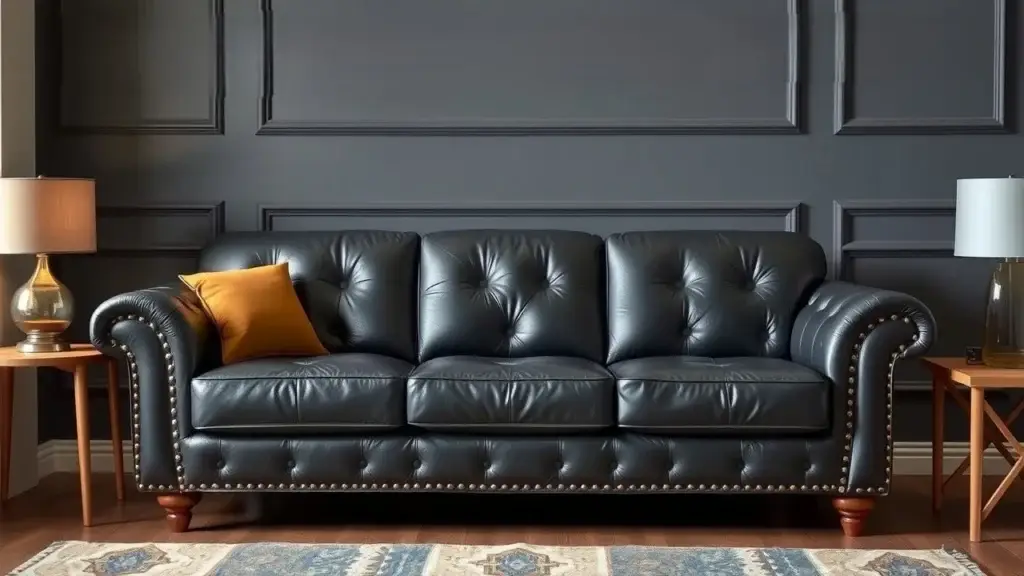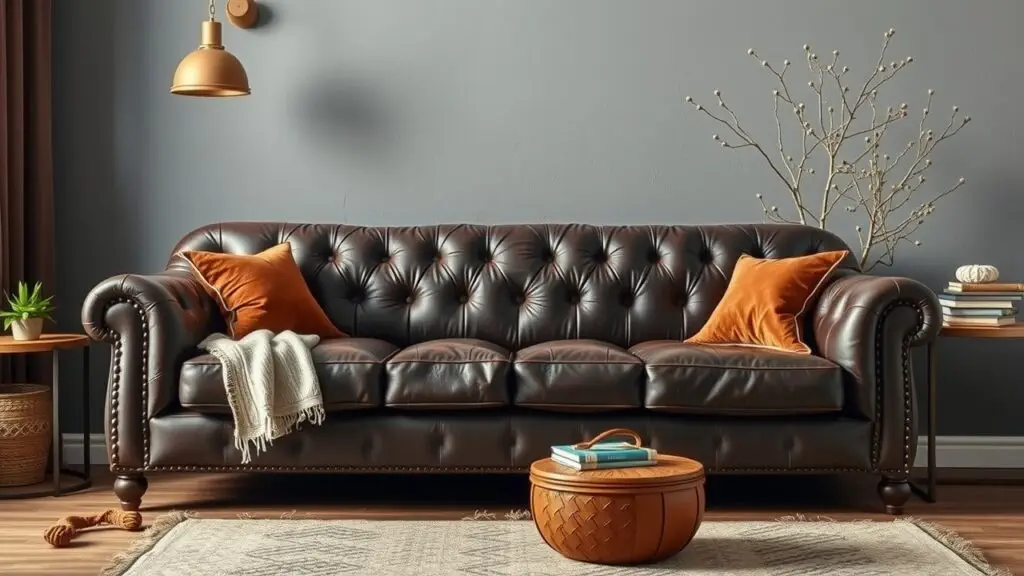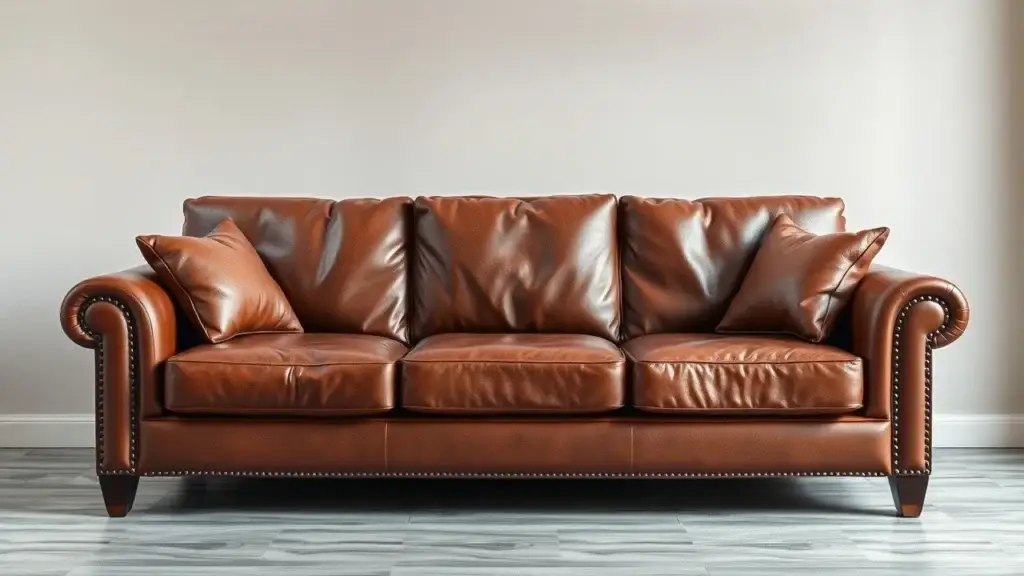The types of leather sofas—full-grain, top-grain, bonded leather, and faux leather—each offer different qualities. This comparison helps you decide which type of leather sofa offers the best value and durability for your home.
What Are Leather Sofas?

Leather sofas are seats made mostly from leather. This material is strong and stylish. You can find different types of leather sofas, each with its own features and benefits. Here are some common types:
- Full-Grain Leather Sofas: These are made from the top layer of animal hide. They keep the natural look, including any small marks. Full-grain is very tough and gets better with age.
- Top-Grain Leather Sofas: These cost a bit less than full-grain. They have been sanded to remove flaws but still look great.
- Genuine Leather Sofas: This is often called “real” leather. It’s made from leftover pieces or lower-quality hides that are treated to look nicer.
- Bonded Leather Sofas: These combine bits of leather with synthetic materials, making them cheaper but not as strong.
- Faux Leather Sofas: Also known as vegan or synthetic leather, these look like real leather but don’t use animal products.
When picking a sofa, think about your style and budget. You can find both luxury and affordable choices in every type.
Why Understanding Different Types of Leather Matters for Sofa Buyers?
Knowing about the types of leather used in upholstery helps you choose the right sofa for you. Each type has different traits that can affect how long it lasts, how much care it needs, how it looks over time, and what it costs:
- Durability: Full-grain leathers are usually the toughest because they are thick and natural. Top-grain also lasts well but might wear out faster with heavy use.
- Maintenance Requirements: Some leathers need special cleaning while others can be wiped down easily with mild soap. Think about how much work you want to put into keeping it nice.
- Price Comparison: The price can be very different among types; full-grain is often more expensive while bonded or faux options are easier on the wallet without losing style.
- Suitability for Families with Pets or Children: If you have kids or pets, top-grain or faux leathers might be better since they resist stains more than full-grain options.
By learning these details—like how to identify correct grain—you can make a smart choice that fits your life and keeps you happy with your purchase!
Types of Leather Used in Sofas Explained
What Is Full-Grain Leather for Sofas?
Full-grain leather is the best leather for sofas. It comes from the top layer of the hide and keeps all its natural grain and flaws. This type is super strong and lasts a long time.
- Durability: Full-grain leather is really tough. It can handle wear and tear well. Its fibers are strong, so it won’t crack or fade easily. Your sofa will look great for many years.
- Care Needs: To care for full-grain leather, just wipe it down with a soft cloth. You should also condition it now and then to keep it shiny. Avoid using harsh cleaners that can harm it.
- Best Use Cases: This leather works best in homes where you want things to last, especially if you have kids or pets who might be rough on furniture.
What Is Top-Grain Leather for Sofas?
Top-grain leather is another popular choice for sofas. It also comes from the top layer of the hide but has been sanded to remove flaws. This gives it a more even look while keeping some durability.
- Affordability: Top-grain is usually less expensive than full-grain but still offers good quality. It’s a smart choice for people looking for stylish but affordable leather sofas.
- Characteristics: Top-grain leathers often come as pigmented or corrected grain leathers. This means they get extra treatments to improve how they look and feel. Semi-aniline finishes make them softer without losing too much strength.
Genuine Leather in Furniture – What You Need To Know
Genuine leather is real animal hide used in furniture, but it doesn’t guarantee high quality like full or top grain does. It’s usually lower grade but is a budget-friendly option.
- Lower Grade Usages Explained: Genuine leather may have visible marks or scars that don’t meet higher standards, but it still feels more real than fake materials.
- Types of Leather Furniture Options: If you’re considering genuine leather because you want to save money, think about how these sofas fit into your life in terms of upkeep versus how they look.
Bonded Leather Sofas: The Affordable Option
Bonded leather sofas are made from leftover pieces mixed with plastic materials. They offer a low-cost way to get the look of real leather without spending too much.
| Aspect | Details |
|---|---|
| Manufacturing Process | Made by bonding together small pieces of genuine hide with polyurethane layers |
| Durability | Not as durable as pure leathers; can peel over time |
| Ideal Use Cases | Works well in low-traffic areas or temporary setups |
Aniline and Semi-Aniline Leather Sofas: Luxury and Practicality
Aniline leather is dyed with special dyes that let it keep its natural texture, giving a luxurious feel. But watch out! It’s more prone to stains than other types, like semi-aniline leathers, which offer more protection while still feeling nice.
Aniline Leather Characteristics:
- Soft touch
- Needs regular care
Pros & Cons (Durability vs Maintenance)
Pros:
Looks great
Breathable
Cons:
Needs lots of care
Can stain easily
Ideal Use Cases
Best used in adult-only areas where spills are less likely.
Semi-Aniline Leather Characteristics
Semi-aniline gives extra stain protection while staying soft enough so users don’t miss out on comfort!
Pros & Cons (Maintenance vs Cost)
Pros:
Good at resisting stains.
Cons:
Usually costs more.
Ideal Use Cases
A great choice if you want something that looks good and holds up well!
Choosing the Right Leather for Your Needs

When picking a leather sofa, think about your life, budget, and how you want your home to look. These factors help you make the best choice.
Lifestyle Factors
Your home life is key in choosing leather for your sofa. If you have pets or kids, you’ll want something strong. Full-grain and top-grain leathers are good options. They can handle wear and tear well. If you don’t have many visitors or just want a softer feel, genuine leather might be okay, but it needs more care.
For homes with kids or pets, bonded leather could work since it’s cheaper and easy to clean. But remember, it won’t last as long as better-quality leathers. No matter what kind you choose, clean spills right away and use the right products to keep your sofa looking good.
Budget Considerations
Leather sofas come in a range of prices based on the type of leather used. High-end options like full-grain leather cost more because they last longer and look better. Budget-friendly choices like bonded or faux leathers are cheaper at first but may need replacing sooner.
Here’s a quick comparison of different types:
| Type | Price Range | Durability |
|---|---|---|
| Full-Grain Leather | High | Very Durable |
| Top-Grain Leather | Moderate-High | Durable |
| Genuine Leather | Moderate | Fairly Durable |
| Bonded Leather | Low | Less Durable |
Knowing how price connects to quality helps you pick a sofa that fits your budget and lasts.
Matching Leather Type to Interior Design Style
Different homes need different looks for furniture. Modern spaces often look great with contemporary leather sofas made from smooth top-grain hides. These give a clean feel and are easy to take care of. Traditional styles may prefer full-grain options that add warmth with rich colors.
Rustic designs can use distressed leathers that bring character through natural flaws while providing comfort. When choosing your new sofa, think about how it fits in with your current decor colors and textures.
Maintenance Requirements
Taking care of a leather sofa depends on what kind you have:
- Full-Grain & Top-Grain Leathers: Use special cleaners for these types; don’t use harsh chemicals.
- Genuine Leathers: Wipe them down with a damp cloth regularly; conditioning every six months helps keep them soft.
- Bonded Leathers: Clean up spills right away with mild soap; they’re easy to manage but should still be treated gently.
By knowing how to care for each type and considering your lifestyle needs, you’ll find it easier to choose the right leather sofa for your home today!
Leather Sofa Care and Maintenance Guide
Taking care of your leather sofa helps keep it looking great for years. Different types of leather need special cleaning and care methods. This guide shows you how to clean, protect, and inspect your leather sofa properly.
Cleaning and Conditioning Recommendations (by leather type)
Knowing the type of leather on your sofa is super important. Here’s how to clean and care for each type:
- Full-Grain Leather: Use a gentle cleaner made just for this type. Regular conditioning with a good-quality conditioner keeps it soft.
- Top-Grain Leather: Mix mild soap with water to clean it. Condition every six months to keep it nice and supple.
- Genuine Leather: Dust often! Use conditioners that are good for lower-quality leathers to stop them from drying out.
- Bonded Leather: Just wipe it down with a damp cloth. Don’t use too much water because it can ruin the surface.
- Aniline & Semi-Aniline Leather: These types need special cleaners since they have tiny pores. Sometimes, use protective sprays to keep stains away.
Protecting from Sunlight and Excessive Heat
Sunlight can fade your sofa’s color. Here are some tips to keep your sofa safe:
- Keep sofas away from windows.
- Think about using UV-protective window films.
- Don’t put sofas near heat sources like radiators or fireplaces; these can dry out the leather.
By taking these steps, you help maintain the color and feel of your leather sofa.
Appropriate Cleaning Products
It’s important to choose the right cleaning products for your sofa:
- Get pH-balanced cleaners made for specific leathers, like aniline or top-grain.
- Always test any product on a small spot first to make sure it won’t damage the finish.
Using the right products makes cleaning safer for your furniture.
Regular Inspection for Damage
Check your sofa often for signs of wear:
- Look for scratches or cracks.
- Early detection means you can fix small issues before they become big problems that need expensive repairs.
Regular checks help you enjoy your investment longer and keep it looking its best!
Full-Grain Leather Sofas: The Premium Choice
Full-grain leather sofas are a top choice for anyone looking for both luxury and strength in their furniture. This kind of leather comes from the upper layer of animal hide, keeping all its natural texture. Unlike other leathers, full-grain doesn’t get sanded down or treated too much. This means it keeps its special feel and look.
A key feature of full-grain leather is its breathability. This helps air flow through the material, making it comfy to sit on in hot or cold weather. Over time, full-grain leather becomes even more beautiful as it ages, developing a rich patina that adds to its appeal. You might notice small scratches over time, but these usually add character instead of being a problem.
Durability
When you think about durability, full-grain leather shines as the toughest option. Its tightly packed fibers make it more resistant to everyday wear and tear than cheaper leathers like bonded or faux options. If you take care of a full-grain sofa, it can last for many years with little sign of damage or fading.
This high durability makes full-grain great for families with pets or young kids who might spill things or roughhouse on the sofa. While nothing is completely damage-proof, a good-quality full-grain sofa can handle daily use better than many other choices out there.
Ideal Use Cases
Full-grain leather sofas work well in homes where comfort and practicality are important. For families with pets or kids, this type of sofa resists scratches and stains while still feeling fancy and comfortable. Plus, since they get better with age and develop their own unique look, full-grain sofas fit nicely into both modern and classic home styles.
Pros and Cons: Full-Grain Leather Sofas
| Feature | Pros | Cons |
|---|---|---|
| Durability | Most durable type; stands up well to use | Higher initial cost |
| Cost | Long-lasting value | Can be pricey |
| Appearance | Luxurious look; develops character | May show marks easily |
| Maintenance Needs | Easy cleaning with proper care | Needs regular conditioning |
| Breathability | Comfortable all year round | Not waterproof |
Top-Grain Leather Sofas: A Balance of Quality and Price

Detailed Description: Sanding Process, Uniform Appearance, Durability
Top-grain leather is a popular choice for sofas. It comes from the top layer of animal hide. This gives it a smooth and even look. The leather starts with a sanding process to fix imperfections while keeping the natural grain. This makes it strong and nice to look at.
One big plus of top-grain leather sofas is that they are tough. They resist wear and scratches better than full-grain leather because of the sanding. Plus, this leather feels soft, which many people like. If you want durability for a good price, top-grain leather is a great option. It provides quality without being too expensive.
Pros and Cons: Durability, Cost, Appearance, Maintenance, Breathability
| Feature | Pros | Cons |
|---|---|---|
| Durability | Very durable; holds up well | Can get scratched by sharp things |
| Cost | Cheaper than full-grain | Costs more than faux or bonded leathers |
| Appearance | Nice look with a smooth finish | May not have the unique style of full-grain |
| Maintenance | Easy to clean with care | Needs regular conditioning |
| Breathability | Good airflow to keep cool | Not as breathable as suede |
Ideal Use Cases: Budget-conscious buyers seeking good durability
Top-grain leather sofas are great for buyers who want something nice but not too pricey. They are mid-range options that give you great durability. This makes them ideal for families or anyone needing stylish yet functional seating without spending too much on luxury materials like full grain or exotic leathers.
Genuine Leather Sofas: Understanding the Terminology
Detailed Description
Genuine leather sofas come from the lower layers of animal hides. They often mix real leather with synthetic materials. This mix can change how strong and durable the sofa is. When you shop for a sofa, keep in mind that genuine leather might not feel as fancy or last as long as higher-grade options like full-grain or top-grain leathers. Still, it looks nice and is usually cheaper.
Composition Details
Knowing how genuine leather is made helps you pick the right sofa. It can include different types, like corrected grain and split grain leathers. Corrected grain leather has been sanded to fix flaws, while split grain comes from the leftover parts after the top layer is removed. Some sofas are labeled PU (polyurethane) leather, which mixes real leather with synthetic stuff to save money but might not feel as good or last as long.
These details help buyers understand what they’re getting so they can make smart choices.
Durability
When talking about leather sofa durability, remember that genuine leather is better than bonded or faux leathers. But it may not hold up as well under heavy use like full-grain or top-grain options do. If you have pets or kids, think about how much wear your sofa will get before making a choice.
Pros and Cons
Pros:
Affordable price
Variety in styles
Cons:
Lower quality than full-grain.
Less durable than premium leathers.
Ideal Use Cases
Genuine leather sofas are great for people who want a stylish option on a budget. They work well in homes where furniture isn’t used too much, like apartments. If your furniture doesn’t face heavy wear from pets or kids, then a genuine leather sofa might be just what you’re looking for.
Frequently Asked Questions (FAQs) about Types of Leather Sofas
What is the best type of leather for a sofa?
Full-grain leather is considered the best type for durability and appearance. It maintains its natural grain and develops a rich patina over time.
How does the lifespan of leather sofas vary by type?
The lifespan of leather sofas depends on the type. Full-grain can last decades, while bonded leather may only last a few years due to its lower quality.
Are there different styles of leather sofas?
Yes, leather sofas come in various styles like modern, traditional, rustic, and sectional designs. Each style fits different home aesthetics.
What types of leather are used in sofas?
Sofas can use full-grain, top-grain, genuine, bonded, faux, aniline, semi-aniline, and patent leathers. Each type has unique properties and care needs.
Can I use a slipcover on a leather sofa?
Yes, slipcovers protect your leather sofa from stains and wear. They offer easy cleaning options and can refresh your sofa’s look.
How do I maintain my leather sofa?
Regular cleaning with appropriate products is essential. Condition your sofa every six months to keep it soft and supple.
Additional Insights on Leather Sofas
- Leather Sofa Features: Different types have specific features like breathability or stain resistance. This affects comfort and maintenance needs.
- Leather Sofa Care Tips: Use gentle cleaners suited for your leather type. Avoid direct sunlight to prevent fading.
- Leather Sofa Cleaning Products: Invest in high-quality cleaners and conditioners designed for leather to ensure longevity.
- Leather Sofa Repair Kits: Repair kits are handy for fixing minor scratches or scuffs on your leather furniture.
- Distressed Leather Sofas: These sofas showcase intentional imperfections for a rustic look. They add character to your space.
- Leather Sofa Brands: Many reputable brands offer various styles and prices. Research before purchasing to find the best fit for your needs.
- Types of Leather Couches Explained: Knowing different couch types helps you choose one that suits your style and family needs.
- Luxury vs. Affordable Leather Sofas: Luxury sofas offer superior materials but come at a higher price point compared to budget-friendly options that may not last as long.
This concise information will help you understand the variety of leather sofas available and make informed decisions when choosing one for your home.
Related Topics
- types of leather
- types of leather furniture
- types of leather finishes
- types of sofa leather
- types of couches



Types of Leather Sofas: Full Grain, Top Grain, Bonded Leather, and Faux Leather Compared